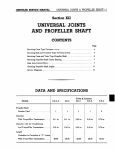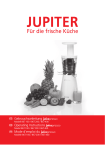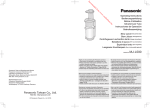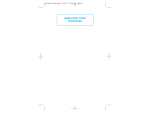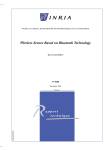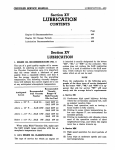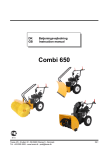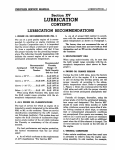Download Section XII UNIVERSAL JOINTS AND PROPELLER SHAFT
Transcript
Section XII UNIVERSAL JOINTS AND PROPELLER SHAFT SERVICE BULLETIN REFERENCE NUMBER DATE SUBJECT CHANGES CHRYSLER SERVICE MANUAL UNIV JOINTS AND PROPELLER SHAFT—537 UNIVERSAL JOINTS AND PROPELLER SHAFT DATA AND SPECIFICATIONS C-67 C-68 C-69 C-70 C-300 Propeller Shaft Number used Diameter With Standard Transmission. 31/2 in. With PowerFlite Transmission 3 in. 3 in. 31/2 in. With Air Conditioning 3 in. 31/2 in. 31/2 in. Length Centerline to Centerline of "U" Joints 59% in. 61 25 / 32 in. Flange to Flange Front and Rear 2V2 in. Front and Rear 2V2 in. 58i/8 in. 6iy 2 in. 31/2 in. 3V2 in. (Front) 52% in. (Rear) 29n/ 16 in. 60%2 in. 6iy 2 in. *Pre-Pack Lubrication . . . . Universal Joints Type (Front) Ball and Trunnion Type (Rear) Cross Type Bearing Type Cross Type (Only) (Front) Ball and Trunnion (Rear) Cross Type Anti-Friction 'Every 20,000 miles TIGHTENING REFERENCE Foot-Pounds Ball and Trunnion Type Joint Attaching Bolts 55 Cross Type Joint Attaching Bolts 20 Spline Oil Seal Cap 25 Companion Flange Nut NOTE: These specifications are for standard axle ratios. 150 538—UNIV JOINTS AND PROPELLER SHAFT CHRYSLER SERVICE MANUAL ROLLER AND BUSHING ASSEMBLY ROLLER AND BLOCK ASSEMBLY PROPELLER SHAFT BLOCK RETAINER BUSHfNG RETAINER BLOCK RETAINER LOCKWASHER ROLLER DUST SEAL DUST SEAL RETAINER SHAFT BOLT CROSS ASSEMBLY ROLLER AND BLOCK ASSEMBLY BUSHING RETAINER ROLLER DUST SEAL ROLLER AND BUSHING ASSEMBLY DUST SEAL RETAINER 55x767 Fig. 1—Rear Universal Joint-Cross Type (Disassembled View) CENTERING BUTTON - »" BUTTON SPRING BALL A N D ROLLERS GREASE COVER THRUST WASHER BODY PROPELLER SHAFT BALL A N D ROLLERS LOCKWASHER SHAFT BOLT BUTTON SPRING CENTERING BUTTON 54x49 Fig. 2—Front Universal Joint-Ball and Trunnion Type (Disassembled View) CHRYSLER SERVICE MANUAL UNIV. JOINTS AND PROPELLER SHAFT—539 Section XII UNIVERSAL JOINTS AND PROPELLER SHAFT UNIVERSAL JOINTS Two types of Universal Joints are used on the 1955 Chrysler Models and are as follows: The Cross Type, as shown in Figure 1, and the Ball and Trunnion Type, as shown in Figure 2. The ball head of each joint of the Ball and Trunnion Type, is an integral part of the tubular propeller shaft and is covered by the joint body. The pin, with the balls, needle bearings, thrust washer, centering button, and button spring at each end, extends through the propeller shaft ball and rides in the ball channels in the body of the joint assembly. This balanced installation is designed to absorb the thrust and torque of the drive line. This type of joint is used in Models C-67, C-68, C-69 and C-300 at the front universal joint. The Cross Type universal joint is used at the rear joint of all models, and the front and center bearing joints of the C-70 Models. The C-70 Models are equipped with a center bearing and two propeller shafts. No adjustments are provided to compensate for wear in the universal joint assembly. Parts that show excessive wear must be replaced. CAUTION When disassembling universal joints, keep parts identified as to original position. Failure to assemble parts in their original positions may cause an unbalanced condition in the propeller shaft. CROSS TYPE 1. SERVICING CROSS TYPE UNIVERSAL JOINTS (Fig. 1) (1) Disconnect front end of propeller shaft at transmission flange. (2) Disconnect rear end of propeller shaft and remove propeller shaft. (3) Remove two bushing retainers and remove bushings. Tilt the cross so that it may be removed from the propeller shaft yoke. (4) Straighten out the end of the retainer lock and remove the two roller and block assemblies. (5) Remove the dust seals and retainers. (6) Inspect parts and replace parts that show wear. (7) Lubricate the roller and bushings with universal joint grease (extreme pressure) and assemble joint in reverse order of disassembly. 540—UNIV. JOINTS AND PROPELLER SHAFT CHRYSLER SERVICE MANUAL BALL AND TRUNNION TYPE 2. SERVICING BALL AND TRUNNION TYPE UNIVERSAL JOINTS To disassemble universal joint for repair or inspection of all component parts, refer to Figure 2 and proceed as follows: (1) Remove the joint body metal cover and gasket by bending tabs of cover away from the body; then remove cover and gasket. (2) Slide body down on propeller shaft exposing the two centering buttons. Remove the centering buttons and springs from the ends of the trunnion pin. (3) Slide the two balls, rollers, and thrust washers off the trunnion pin. (4) Wash all parts with cleaning solvent and blow dry with compressed air. Inspect and replace worn parts. NOTE Reconditioning of ball and trunnion type universal joints will only be necessary when excessive free backlash exists between the balls and the trunnion. In some instances, it will be found that the universal joint body has worn, and it will be necessary to replace all parts, including the body pin, thrust washers, and centering buttons. Worn rollers should also be replaced. 3. UNIVERSAL JOINT MAINTENANCE (BALL AND TRUNNION) The universal joints, propeller shaft, and hand brake drum are accurately balanced during the process of manufacture. Care should be exercised to maintain this condition of balance by close adherence to the following: (1) Do not use more than 2% ounces of lubricant in a universal joint (ball and trunnion type) at any time. (2) Keep the propeller shaft, hand brake drum, flanges, etc. free from undercoating, dirt, and ice. CAUTION When installing trunnion pin in propeller shaft care should be taken to see that the trunnion pin is centered in the shaft. Each end of pin should protrude the same distance, with a variation of no more than .003 inch. If one side of the pin extends more than .003 inch farther than the other, the propeller shaft will be out of balance. Tool C-552, as shown in Figure 3, will facilitate the removal, installation, and centering of the trunnion pin. (3) Failure to observe these recommendations may result in an out-of-balance condition causing vibration. 4. SERVICING EXTERNAL TYPE UNIVERSAL JOINT DUST COVER Fig. 3—Installing Universal Joint Pin To replace an external type universal joint dust cover (Fig. 4) that is damaged, remove the propeller shaft assembly from the car and clamp lightly in a vise. One end of the shaft should be resting on the bench in a horizontal position, then proceed as follows: CHRYSLER SERVICE MANUAL UNIV. JOINTS AND PROPELLER SHAFT—541 55x766 Fig. 4—External Type Dust Cover Fig. 6—Working Dust Cover Through Body (1) Disassemble joint, removing all parts except the body and pin. (2) Clean body, ball head, and pin thoroughly. (3) A complete coating of grease (or suitable rubber lubricant) must be smeared on the outside and inside of dust cover, entire surface of the ball head, pin, and inside of body. (It is very important that this instruction be followed.) (4) Stretch the grease-soaked boot or dust cover over the pin and ball head as shown in Figure 5. (5) Work the dust cover into the body as far as possible. UNIVERSAL JOINT CENTERING PIN PROPELLER SHAFT CAUTION USE NO TOOLS FOR THIS OPERATION. (6) With the body in position so the pin can enter the ball channels, pull the body sharply over the pin, thereby forcing the dust cover into the body. (7) With one hand, grip the end of the dust cover, protruding through the back end of body. With the other hand, pump the body back and forth, as shown in Figure 6, until the entire dust cover has passed through the body. (8) During the operation the cone may have reversed itself inside the dust cover. Pull it out to its normal position. (9) Slide, the dust cover in the ball head groove and over the neck of the body, then secure with clamps provided. (10) Insert 21/2 ounces of heavy fiber, universal joint grease in the joint and install the cover. (11) Install shaft, using new lockwashers. Be sure to double check the flange bolts for tightness, to insure against grease leakage. Recheck after 1,000 miles of operation. UNIVERSAL JOINT DUST COVER OR BOOT UNIVERSAL JOINT BODY 49x910 Fig. 5—Sliding Cover over Ball Head and Pin CAUTION Never attempt to use a needle-like arrangement for forcing lubricant into the boot (or dust cover) on the universal joints. Excessive grease 542—UNIV. JOINTS AND PROPELLER SHAFT CHRYSLER SERVICE MANUAL CLAMP GROOVE (LARGE) JOINT BODY BALLHEAD 55x771 Fig. 7—internal Type Dust Cover DUST COVER' can be forced into the boot and cause the shaft to be thrown out of balance, burst boot, or the lubricant can be lost through the injection hole during high speed operation. The joints must be disassembled and packed with universal joint grease. 5. SERVICING INTERNAL TYPE UNIVERSAL JOINT DUST COVER The propeller shafts incorporating the internal type dust covers (Fig. 7) are standard on the C-300 Models, and New Yorker Models equipped with air conditioning. To replace a damaged dust cover proceed as follows: (1) Remove propeller shaft from car, and lightBODY v—-• 55x772 Fig. 9—Installing Small Clamp on Dust Cover ly clamp shaft in a vise, with the other end supported in a horizontal position. (2) Disassemble joint; remove all parts except the body and pin. (3) Clean all parts including body, ball head, and pin thoroughly. (4) Push body all the way back, install boot by stretching it over the ball head and pin, as shown in Figure 8. No lubricant applied to any parts thus far. (5) Position boot as near to ball head as possible, then form small clamp around boot and thread one end of clamp through slot provided in other end of clamp. (6) Use suitable pliers to constrict clamp as far as possible by hand (Fig. 9). Secure clamp by bending end of clamp completely over. Do not cut off excess amount of clamp. (7) Apply light coat of universal joint grease to inside of body. This will aid in working boot through body. BALLHEAD (8) Install thrust washers, balls, rollers, etc. on ends of pin. DUST COVER PIN 55x768 Fig. 8—Sliding Dust Cover over Ball Head and Pin (9) Pull body over ball head and work back and forth until boot protrudes enough to be grasped with fingers; then pull boot through body, as shown in Figure 10. CHRYSLER SERVICE MANUAL UNIV. JOINTS AND PROPELLER SHAFT—543 DUST COVER BODY 55x770 55x769 Fig. 10—Working Dust Cover Through Body Fig. 11—Cleaning Lubricant from Contacting Surface of Dust Cover CAUTION Do not use any sharp tool for this operation. cessive amount of clamp and completely bend end of clamp over. (10) Wipe off any lubricant from contacting surfaces on both body and boot (Fig. 11). Clean the clamp groove also on the outside of boot. THIS IS IMPORTANT. (12) Coat ball head assembly and inside of body with 2 ounces of universal joint grease. Work body back and forth so that grease will be distributed on all parts. (11) Install clamp, using same procedure as described for the small clamp. Cut off ex- (13) Install gasket and grease cover. Bend tabs of cover over to secure cover. CROSS AND YOKE TYPE PROPELLER SHAFT 6. SERVICING CROSS AND YOKE TYPE PROPELLER SHAFT a. Removal Remove nuts and lockwashers holding universal joint and propeller shaft to differential and transmission companion flanges. Remove propeller shaft assembly. b. Disassembly (1) Place assembly in a bench vise and remove the cross roller bearing block tie retainer which holds the cross roller bearing blocks on cross. (2) Remove bearing blocks, dust seals, and dust seal retainers. (3) Remove retainers from cross roller bearings. Press out bearings and cross. (4) Remove dust seals and retainers from cross. The cross roller bearing block and its component parts form an assembly. The cross roller bearing, with its component parts, also form an assembly. These parts are not serviced separately. After disassembly, clean and inspect the parts and replace, as necessary, those worn or damaged. 544—UNIV. JOINTS AND PROPELLER SHAFT CHRYSLER SERVICE MANUAL Fig. 12—Balance Arrows c. Assembly Lubricate all parts before assembling. If the splined joint at the front of the propeller shaft has been disassembled, fill cavity with 5 ounces (by weight) of MS 870 pressure gun, winter grade, chassis grease. On 8-passenger models, the center bearing is a sealed bearing and does not require lubrication. 51x854 Fig. 14—Removing Companion Flange Nut sure balance arrows are in alignment (Fig. 12). (1) Install dust shields and retainers on cross. Place propeller shaft in its correct position under car. Make certain that the slip-spline end of the shaft is located toward front of car. Insert attaching screws and tighten securely. (2) Press the cross roller bearing and bushing assembly into the yoke with the cross in proper location. CAUTION Make certain that all of the roller bearings are correctly placed in the roller bushing. Also, be COTTERPIN DUST SLINGER HOUSING 7. SERVICING PROPELLER SHAFT CENTER BEARING The center bearing and housing must be removed CENTER BEARING NUT WASHER FLANGE LOCKWASHER NUT Fig. 13—Propeller Shaft Center Bearing— Disassembled View (8 Passenger Models) CHRYSLER SERVICE MANUAL UNIV. JOINTS AND PROPELLER SHAFT—545 FRONT PROPELLER SHAFT FRONT PROPELLER SHAFT 51x857 Fig. 17—installing Companion Flange 51x855 Fig. 15—Removing Companion Flange FRONT PROPELLER SHAFT quired. (Refer to Fig. 13.) The service procedure is as follows: (1) Clamp front propeller shaft in a vise and remove cotter pin. Place Tool C-784 over flange (Fig. 14) and remove flange nut and flat washer. (2) Index and mark flange and shaft (to retain original balance). Remove flange and slinger from shaft with Tool C-452, as shown in Figure 15. (3) With the jaws of Tool C-459 over the housing, as shown in Figure 16 (be careful not to crimp slingers), force slingers and bearing off the shaft. 51x856 Fig. 16—Removing Center Bearing from Shaft (4) Remove bearing from housing with a suitable drift. as a unit, together with the front propeller shaft, for servicing. When installing new bearing, use drift, Tool C-202, being careful to start bearing evenly to avoid distorting bushing. The splined center flange is fastened to the end of the propeller shaft and holds the slingers and center bearing securely on the shaft. The center bearing, housing, and slingers, can be disassembled, inspected, and parts can be replaced as re- Insert splined end of shaft with slinger through bearing and slide center bearing flange over shaft. Draw flange on shaft with Tool C-496, as shown in Figure 17. Tighten nut to 150 footpounds torque. 546—UNIV. JOINTS AND PROPELLER SHAFT CHRYSLER SERVICE MANUAL SERVICE DIAGNOSIS 8. PROPELLER SHAFT VIBRATES Possible Causes: a. Undercoating on shaft, flanges, drums, etc. b. Loose companion flange nuts. c. Improper alignment of balance arrows. d. Flange runout. it is possible to correct a flange runout condition by repositioning the universal joint 180 degrees with the companion flange. Reposition only one universal joint at a time and road test car after each repositioning operation. e. Check the splines. If excessively loose, inspect the splines on the shaft or in the flange foi wear or damage. Replace shaft of flange, as necessary, to correct this condition. e. Worn spines on shaft or in flange. Remedies: a. If propeller shaft, drum, and flange are not shielded while car is being undercoated, the undercoating material may accumulate on the underside of the propeller shaft and cause vibration. To remedy such a condition, inspect shaft and remove the undercoating material (if present) with a suitable solvent. b. Check transmission flange nuts and rear axle differential flange nuts for looseness. Tighten to Data and Specifications. c. Check alignment of balance arrows on both shaft and front universal joint. These arrows must be exactly in line. If not, reposition splines so that arrows are properly aligned. d. Check for flange runout. In many instances, 9. UNIVERSAL JOINTS NOISY Possible Causes: a. Loose propeller shaft flange bolts. b. Improper lubrication. c. Worn universal joint bearings. Remedies: a. Check universal joints for possible damage and tighten propeller shaft flange bolts to Data and Specifications. b. Disassemble universal joints and inspect all parts for wear or damage. Replace parts as required, pack bearings with universal joint grease and reassemble. c. Inspect universal joint bearings for wear and replace as necessary.











